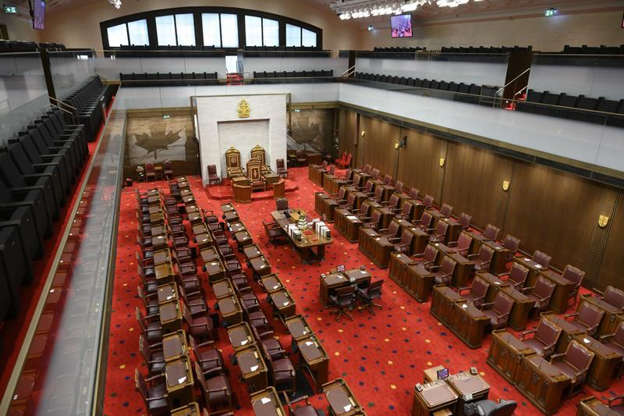Alberta
German Fitness Trainer Finds Himself Stuck in Calgary – And Making the Best of It!

Cultures collide as COVID-19’s descent on the world leaves personal trainer global adventurer Darian Bessell stuck in Calgary.
Originally from Germany, Darian has been travelling the world for the last year and a half, landing in Canada in February with plans to stay and work for a year. After getting all his permits in place and obtaining a work visa, he was hired by one of the major gyms in Calgary as a personal trainer. Unfortunately, he was immediately laid off after COVID-19 hit the city.
Seeing the situation as an opportunity to strike out on his own, Darian began offering his services as a personal trainer online, offering free consultations by Zoom or in person. His first client, Matt Keay, connected with Darian during his search for a way to improve health and mobility as well as mental wellbeing in his demanding role as a CEO.
“I look over at my two-year-old daughter and she’ll be holding a squat position playing with toys for nearly an hour, totally natural for her,” says Keay, “why can’t I do that?” Keay suffers from sore hips and wrists due to years of abuse from skateboarding and poor diet. This proves difficult, as his role as a leader demands high performance and consistent energy.

“I’ve got training every day with Darian … well, it’s more like all day long,” says Matt, “I’ve heard people say how fitness is a lifestyle, well I really understand that now. I am standing more at my desk, doing more stretches, busting into a squat in the boardroom and the pain I’ve dealt with for years is melting away.”
Darian Bessell, newly appointed Business on Camera Director of Physical and Mental Health will bring health and wellness to high-performance entrepreneurs in Calgary. “The knowing-doing gap is a worldwide common issue,” offers Bessell, “people know that enjoying nuts as a snack is healthier than a chocolate bar, and they know the way they feel physically could be better. Often some simple support tools to improve mobility can have a huge impact on overall fitness and hold the key to a new healthy lifestyle.”
The human body sends signals that it is in poor condition by aching and demonstrating discomfort. The mind also sends signals, for example, feeling depressed or tired all the time. Most people know that they have to change something, but it is all too easy to get caught up in routines and maintain bad habits.
“Most people have the desire to do more for their mental and physical health, so why not just do it then?”
Health and fitness is one of the most flooded industries on the market with new gadgets, diets and methods constantly emerging, leaving no shortage of options when it comes to personal health.
“Choosing to work with Darian was based on the education he had regarding the symbioses between mental health and physical performance, nutrition and mobility. He often referred to a program created by Dr. Kelly Starrett called “Becoming a Supple Leopard,” continues Keay, “a ton of professional athletes and stunt actors are Supple Leopards; I would describe it as intentional and intuitive. For me at this time, the goal is to feel better everywhere, increase mobility, energy, and mood in under thirty minutes a day.”
Darian’s goal is to help individuals overcome the disconnect between desire and action by cultivating discipline and a strong commitment to health and happiness in his clients. “People have to take a huge step to get over the gap between knowing what is good for them and really having the discipline to do it,” says Bessell, “Human beings get used to things so fast and fall into a cycle of ‘I need to do something about that’, then continue to ignore it, and fall into the deep hole between knowing and doing.”

Darian gives people that much-needed kick in the butt. By helping clients reposition their approach to fitness and replace negative habits with positive changes, his program addresses physical and mental wellbeing, leaving clients feeling better than ever. “Other benefits include better sleep, more focus and better work-life balance,” says Darian, “it is all about implementing a holistic approach to health to get your body in an efficient, healthy position, and maintain it with intentional practice.”
Keay is thrilled with his results and excited to see where the program takes him. “I am constantly paying attention to my body now,” he says, “the way I sit, the way I walk, engaging my core, doing a squat instead of bending over to pick something up…it’s really had a tremendous impact on my ability to move properly, and we’re just getting started.”
Darian can be reached by phone at 403-478-3836 or [email protected]
For more stories, visit Todayville Calgary.
Alberta
Made in Alberta! Province makes it easier to support local products with Buy Local program

Show your Alberta side. Buy Local. |
When the going gets tough, Albertans stick together. That’s why Alberta’s government is launching a new campaign to benefit hard-working Albertans.
Global uncertainty is threatening the livelihoods of hard-working Alberta farmers, ranchers, processors and their families. The ‘Buy Local’ campaign, recently launched by Alberta’s government, encourages consumers to eat, drink and buy local to show our unified support for the province’s agriculture and food industry.
The government’s ‘Buy Local’ campaign encourages consumers to buy products from Alberta’s hard-working farmers, ranchers and food processors that produce safe, nutritious food for Albertans, Canadians and the world.
“It’s time to let these hard-working Albertans know we have their back. Now, more than ever, we need to shop local and buy made-in-Alberta products. The next time you are grocery shopping or go out for dinner or a drink with your friends or family, support local to demonstrate your Alberta pride. We are pleased tariffs don’t impact the ag industry right now and will keep advocating for our ag industry.”
Alberta’s government supports consumer choice. We are providing tools to help folks easily identify Alberta- and Canadian-made foods and products. Choosing local products keeps Albertans’ hard-earned dollars in our province. Whether it is farm-fresh vegetables, potatoes, honey, craft beer, frozen food or our world-renowned beef, Alberta has an abundance of fresh foods produced right on our doorstep.
Quick facts
- This summer, Albertans can support local at more than 150 farmers’ markets across the province and meet the folks who make, bake and grow our food.
- In March 2023, the Alberta government launched the ‘Made in Alberta’ voluntary food and beverage labelling program to support local agriculture and food sectors.
- Through direct connections with processors, the program has created the momentum to continue expanding consumer awareness about the ‘Made in Alberta’ label to help shoppers quickly identify foods and beverages produced in our province.
- Made in Alberta product catalogue website
Related information
Alberta
Province to expand services provided by Alberta Sheriffs: New policing option for municipalities

Expanding municipal police service options |
Proposed amendments would help ensure Alberta’s evolving public safety needs are met while also giving municipalities more options for local policing.
As first announced with the introduction of the Public Safety Statutes Amendment Act, 2024, Alberta’s government is considering creating a new independent agency police service to assume the police-like duties currently performed by Alberta Sheriffs. If passed, Bill 49 would lay additional groundwork for the new police service.
Proposed amendments to the Police Act recognize the unique challenges faced by different communities and seek to empower local governments to adopt strategies that effectively respond to their specific safety concerns, enhancing overall public safety across the province.
If passed, Bill 49 would specify that the new agency would be a Crown corporation with an independent board of directors to oversee its day-to-day operations. The new agency would be operationally independent from the government, consistent with all police services in Alberta. Unlike the Alberta Sheriffs, officers in the new police service would be directly employed by the police service rather than by the government.
“With this bill, we are taking the necessary steps to address the unique public safety concerns in communities across Alberta. As we work towards creating an independent agency police service, we are providing an essential component of Alberta’s police framework for years to come. Our aim is for the new agency is to ensure that Albertans are safe in their communities and receive the best possible service when they need it most.”
Additional amendments would allow municipalities to select the new agency as their local police service once it becomes fully operational and the necessary standards, capacity and frameworks are in place. Alberta’s government is committed to ensuring the new agency works collaboratively with all police services to meet the province’s evolving public safety needs and improve law enforcement response times, particularly in rural communities. While the RCMP would remain the official provincial police service, municipalities would have a new option for their local policing needs.
Once established, the agency would strengthen Alberta’s existing policing model and complement the province’s current police services, which include the RCMP, Indigenous police services and municipal police. It would help fill gaps and ensure law enforcement resources are deployed efficiently across the province.
Related information
-

 2025 Federal Election15 hours ago
2025 Federal Election15 hours agoCanada drops retaliatory tariffs on automakers, pauses other tariffs
-

 espionage8 hours ago
espionage8 hours agoEx-NYPD Cop Jailed in Beijing’s Transnational Repatriation Plot, Canada Remains Soft Target
-

 2025 Federal Election1 day ago
2025 Federal Election1 day agoBureau Exclusive: Chinese Election Interference Network Tied to Senate Breach Investigation
-

 2025 Federal Election1 day ago
2025 Federal Election1 day agoNeil Young + Carney / Freedom Bros
-

 2025 Federal Election16 hours ago
2025 Federal Election16 hours agoTucker Carlson Interviews Maxime Bernier: Trump’s Tariffs, Mass Immigration, and the Oncoming Canadian Revolution
-

 Business16 hours ago
Business16 hours agoDOGE Is Ending The ‘Eternal Life’ Of Government
-

 2025 Federal Election2 days ago
2025 Federal Election2 days agoMEI-Ipsos poll: 56 per cent of Canadians support increasing access to non-governmental healthcare providers
-

 2025 Federal Election1 day ago
2025 Federal Election1 day agoRCMP Whistleblowers Accuse Members of Mark Carney’s Inner Circle of Security Breaches and Surveillance








